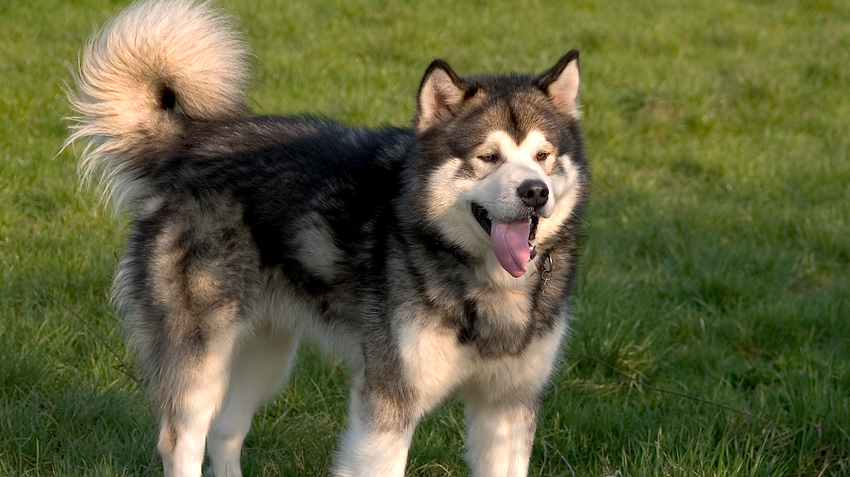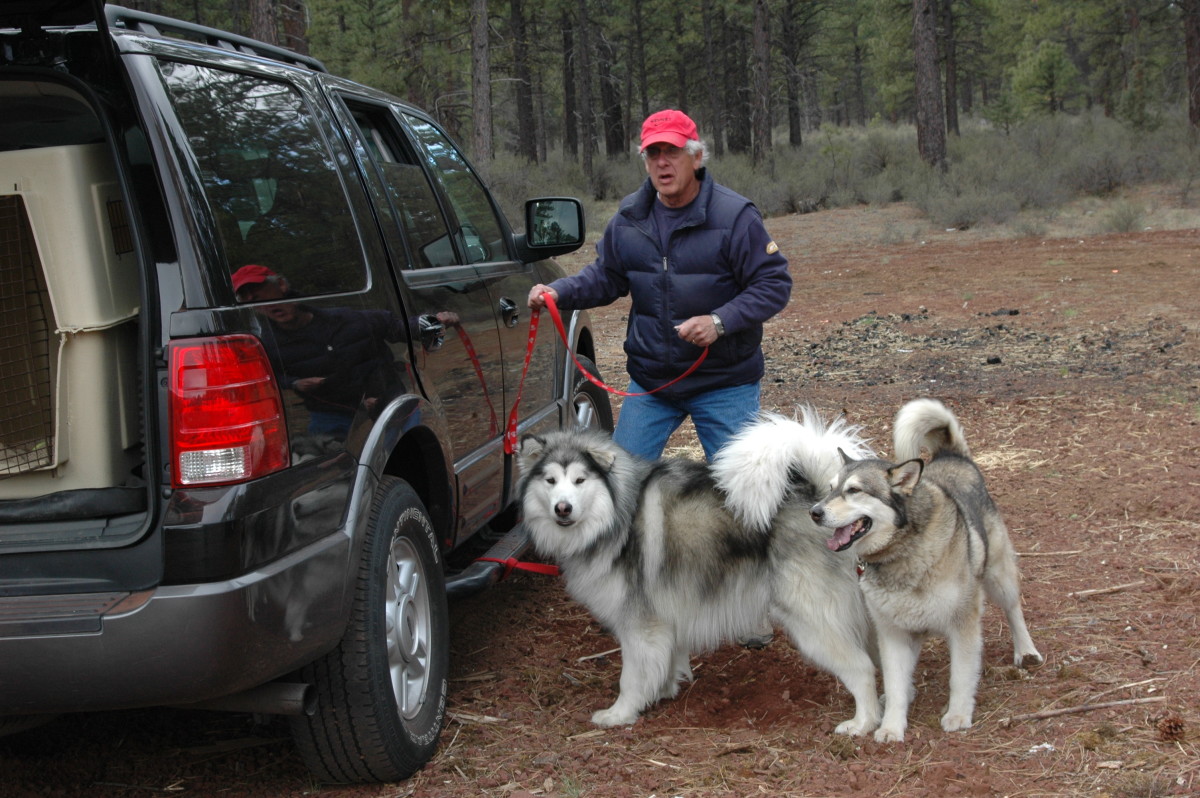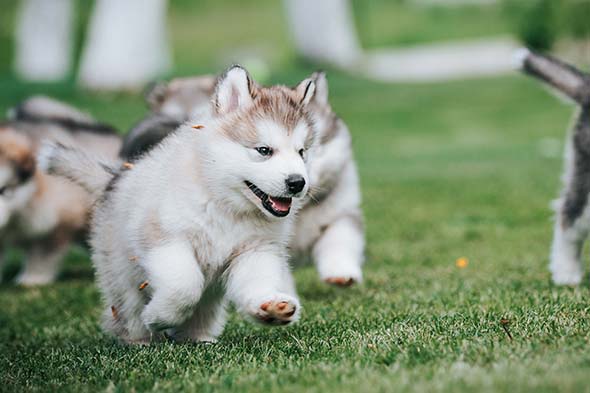Pet Dogs, Taking care of pets
10 things to know about Alaskan Malamute
History of the origin of the Alaskan Malamute
The Alaskan Malamute is not only famous for its beautiful appearance but also for its rich history and origin. To have a healthy and happy Alaskan Malamute, make sure you have enough knowledge and are willing to spend time on training, exercising and caring for them.
- Originating from the Arctic: The Alaskan Malamute is an ancient breed of sled dog from the Arctic region, with a history spanning thousands of years. Unlike the Siberian Husky, the Alaskan Malamute’s strength and endurance have helped them transport heavier loads over long distances.
- Historical Uses: Alaskan Malamutes have helped humans in many historical events, from the Alaskan Gold Rush, Antarctic exploration, to supporting troops in World War II.
- Name: This breed is named after the Mahlemut people, who loved and raised them in Alaska.
- Recognition and popularity: Although the breed suffered after the war, it is still popular today and ranks 67th on the American Kennel Club (AKC ) list of popular breeds . In 2010, the Alaskan Malamute became the state dog of Alaska.
- Physical Characteristics: Originally, the Alaskan Malamute was only medium in size. But over time and through crossbreeding, they became larger, with thick coats and a variety of colors. They have many similarities to wolves and are often confused.
- Lifespan and care: Although the average lifespan is only about 10-12 years, the living environment and exercise regimen can greatly impact the health and longevity of this Alaskan dog breed.
Physical characteristics of Alaskan dogs

In this article, let’s learn more about the outstanding features and lovely personality of this dog breed.
-
- General appearance: The Alaskan Malamute breed shines with its impressive appearance, sturdy build, and well-developed bones and muscles. In particular, with a deep chest and broad shoulders, the Alaskan dog shows strength and spirit. Their heads are large and majestic, creating a gentle and friendly face. The almond-shaped eyes, often bright and flexible, are always full of curiosity and interest in everything around them. The Alaskan dog’s ears stand upright, not too large compared to the face, creating a balanced beauty. Their teeth are strong and even. However, the Alaskan Malamute’s steps show flexibility. The highlight is the diverse coat colors, of which gray and white are the most common. The large, bushy tail is an unmistakable symbol of this breed.
- Head and Face: The head is broad and deep, the facial expression shows gentleness and a loving personality. The eyes are almond-shaped, brown and always curious and friendly. Sometimes, the Alaskan Malamute and the Husky are confused because of many similarities. However, just pay attention, you can easily distinguish: The head is wider, with thick and shaggy hair. Their face has a friendly and affectionate look.
- Size and body proportions: Male – 64cm tall , 39kg in weight . Female – 58cm tall , 34kg in weight. Alaskan dogs have a body that is longer than their height, with a balance between size and bone. Individuals exceeding 54kg are called “Giant Alaskans”. Although the AKC and FCI do not set a specific size, potential health problems make keeping dogs of such large size not recommended.
- Eye color: Regarding eyes, purebred Alaskan dogs only accept two colors: brown and dark brown. Any other eye color, it is easy to know that they have been crossbred.
- Coat: Their guard hair is thick and water-resistant, protecting them from the harsh Arctic weather. The Alaskan Malamute’s coat is its most distinctive feature. With two coats: a long, coarse outer coat and a soft, silky undercoat, they retain heat very well. You can find a variety of colors from black and white, gray and white to red and white brown and sometimes red or yellow.
- Ears and Nose: The ears are triangular in shape and stand erect when they are observing or curious. The nose is usually black, except for red dogs which may have a brown nose.
- Personality: The Alaskan Malamute is not only beautiful in appearance but also friendly, loyal and intelligent. They are very sensitive and easily stressed if confined. Possessing abundant energy, the Alaskan dog breed needs daily exercise. The Alaskan dog is famous for its friendly personality, not picky about people and especially loves children. They are great companions, always ready to participate in games and outdoor activities.
- Habitat: If you live in a hot climate, consider carefully before deciding to raise an Alaskan Malamute. They need a lot of space and regular exercise.
Alaskan Malamute Dog Rating Scale
| Affection for the owner | 3/5⭐ | Housekeeping ability | 4/5⭐ |
| Kid friendly | 3/5⭐ | Ability to be independent | 3/5⭐ |
| Friendly with other pets | 3/5⭐ | Trainability | 5/5⭐ |
| Hair loss level | 3/5⭐ | Energy | 5/5⭐ |
| Grooming needs | 3/5⭐ | Barking frequency | 3/5⭐ |
| Drooling level | 1/5⭐ | Lifespan | 4/5⭐ |
| Open to strangers | 3/5⭐ | Level of fun | 3/5⭐ |
Essential nutrition for Alaskan dogs
The Alaskan Malamute is an energetic, playful and powerfully built dog. To support their health and energy, it is important to provide them with a complete and balanced diet.
- Basic Nutrition: The Alaskan Malamute should be fed a high-quality food, either commercial or homemade, under the guidance of a veterinarian . Be sure to choose a food that is appropriate for the dog’s age and nutritional needs, from puppyhood to adulthood. Monitoring calories and weight is essential to prevent obesity.
- How to feed an Alaskan Malamute: They have high energy needs, so their diet needs to be carefully considered. To determine the best diet, seek advice from a veterinarian or nutritionist. They also need a regular diet, divided into several small meals throughout the day to avoid the risk of bloating and stomach problems.
- Nutrition and feeding: The Alaskan Malamute, with its large and powerful body, needs a special nutritional balance, different from that of small dogs. High quality foods such as MKB , PURINA PRO PLAN , NATURAL… containing moderate protein and fat will help support their good health. Supplementing fatty acids helps their coat become soft, shiny and healthy.
- Diet: They tend to gain weight if their diet is not controlled. A balanced diet, with the right amount of calories, will help them stay in good health. To ensure that your dog does not gain weight, regularly check their weight by feeling their thick coat.
- Recommended Nutritional Requirements: Although the Alaskan Malamute has a thick coat, you should still regularly check their health status by touching and feeling. Puppies should be given a nibble-free diet that allows them to grow steadily. This not only helps them grow properly but also reduces the risk of disease in adulthood.
Exercise and training regimen for Alaskan dogs
The Alaskan Malamute is a wild, strong and energetic dog breed. To help you better understand and apply effective training methods, the article below will share detailed information about the behavior and training of this dog breed.
- Exercise Needs: This breed needs a lot of exercise. If not given enough exercise, the Alaskan Malamute may seek other forms of entertainment, such as “attacking” your favorite sofa.
- Needs attention: Although they love to exercise, when given enough exercise, the Alaskan Malamute makes a great sofa companion, always demanding love and attention from their owner.
- Curiosity: The Alaskan Malamute is very curious and loves to be the center of attention. If bored or unhappy, this breed will not hesitate to express its feelings.
- Positive Approach: Alaskan Malamutes enjoy being trained through a positive approach, using rewards to stimulate them.
- Patience: Although intelligent, Alaskan Malamutes can be stubborn. Sometimes they can hear and understand commands but do not want to obey. Therefore, owners need to be patient and creative in training.
- Minimize digging behavior: As mentioned, they love to dig. You need to minimize this behavior by providing them with plenty of exercise and training.
Alaskan Malamutes love active activities such as walking, jogging, cycling, etc. In particular, participating in sports such as sledging will give them the opportunity to express their natural nature. Training the Alaskan Malamute is not always easy due to their independent and stubborn nature. However, with patience, intelligence and the right method, you can completely help them become your ideal companion.
Alaska dog grooming care
The Alaskan Malamute is known for its thick double coat that helps it cope with the harsh Arctic climate. But to keep this coat looking beautiful and healthy, you need to follow a few basic rules:
- Brushing Properly and Regularly: The thick coat requires consistent care. You should brush your Alaskan Malamute every day, using a wire brush and a special comb. During shedding season, shedding can increase significantly. Add a special undercoat comb to your grooming routine. Do not use a Furminator as it can damage the Alaskan Malamute’s outer coat.
- Proper Bathing and Drying: Alas dogs do not need to be bathed as often as people think. You only need to bathe them about every six to eight weeks. After bathing, dry their coat carefully to avoid irritating their skin.
- Basic Health Care: Check their mouth and teeth regularly. Brush them a few times a week using a toothpaste specifically made for dogs. Your Alaskan Malamute’s nails should be trimmed regularly, about every two months. If you are not confident in trimming their nails, take them to a groomer or veterinarian.
When caring for, brushing, and trimming your Alaskan Malamute, it is important to keep their coat clean and free of tangles. This will not only keep them looking great, but will also keep them healthy and free from many health problems.
Common health problems of Alaskan dogs

The Alaskan Malamute has a lifespan of 10 to 14 years, but like many large breeds, they are prone to some health problems. If you are considering getting an Alaskan Malamute, buy from a reputable breeder who health tests their dogs. Also, take your dog to the vet regularly to catch and treat any health problems early.
The Alaskan Malamute is a healthy and strong breed, but they do have some unique health problems that every owner should be aware of, such as:
- Osteoarthritis of the hip : This is a genetic condition that causes the thigh bone to not fit tightly into the hip joint. This condition can cause pain and inflammation of the joint.
- Osteoarthritis of the elbow : Similar to osteoarthritis of the hip, but in the elbow joint.
- Chondrodysplasia (bone deformity): A genetic condition that causes dwarfism. Affected dogs may have short legs, bow legs, or other bone deformities.
- Cataracts: Clouding of the lens of the eye, dogs with cataracts can go blind.
- Hemeralopia (day blindness): A condition that causes dogs to become sensitive to light, having difficulty seeing into sunlight.
- Hypothyroidism : When the thyroid gland doesn’t produce enough thyroid hormone. Symptoms can include dry hair, weight gain, and hair loss.
- von Willebrand disease : A condition in which the blood does not clot.
- Polyneuropathy (neurogenetic): Affects the dog’s nervous system.
As with all breeds, the Alaskan Malamute’s ears need to be checked and cleaned regularly to remove wax build-up. Their teeth also need to be brushed and cleaned regularly. From a nutritional perspective, to reduce the risk of hip dysplasia, it is necessary to provide the Alaskan Malamute with the right diet from a young age, avoiding rapid weight gain. They also need regular but not excessive exercise, and should be kept out of direct sunlight and tropical heat during hot weather.
Alaska dog breeding and mating methods
The Alaskan Malamute is a very ancient breed. In short, it is a breed of original breed with minimal genetic dilution. Over the centuries, it has retained its original appearance and DNA. The term “original” refers to the special place of the Alaskan Malamute in the history of dog development. They form the foundation for hundreds of modern dog breeds today. Notes when breeding and mating Alaskan dogs:
- Highlights: The Alaskan Malamute is a healthy, intelligent and easy to train dog. However, they need a cool living environment, ideally a cold climate.
- Living Conditions: While they can adapt to your living conditions and lifestyle, humid or extremely hot climates will not be suitable for them.
- Number of puppies: Alaskan Malamutes usually give birth to 6-8 puppies per litter. In rare cases, the number can be up to 12 puppies.
- Genetic Note: Alaskan Malamute breeders should take care to preserve their original genetic sequence. Before breeding dogs , both breeds should be tested for genetics to ensure the best genetic quality.
- Problems and solutions: Some mothers have problems giving birth. In this situation, a cesarean section may be necessary. To ensure the safety of both mother and puppies, always be willing to consult your veterinarian.
To successfully breed and preserve the original genes, breeders need to equip themselves with knowledge and scientific thinking. Take advantage of the above information to have a more in-depth and professional view of this dog breed.
7 reasons to buy and raise an Alaskan dog
Alaska – the land of ice and snow and harsh weather. But do you know that in the midst of that land, there is a special animal that has adapted and become a symbol? Here are the reasons why you should choose to buy and raise an Alaskan dog:
- Their beautiful coat reflects their heritage: Their thick, silky fur helps them withstand the harsh Arctic weather. You’ll see a wide range of unique colors, from pristine white to mysterious gray to vibrant red.
- Friendly, great companion for families with young children: The Alaskan Malamute is known for its gentle, patient and child-loving temperament. Imagine afternoons together, with the kids playing with your dog on the lawn!
- Outstanding “pulling machines”: The Alaskan Malamute is not only a symbol of Alaska but also known as a snow machine. Possessing amazing strength, they are capable of pulling large loads and participating in sled pulling competitions.
- Admirable intelligence and learning ability: Alaskan dogs are the intellectuals of the animal world. With the ability to quickly understand and execute commands, they become the top choice for training rescue dogs and guard dogs.
- Stable health and long life: They are often less prone to health problems common in many other dog breeds. However, you also need to pay attention to their coat, nails and nutrition.
- Joy and optimism spread: Be sure that every day with your Alaskan Malamute will bring laughter and joy to your whole family.
- Companionship and absolute loyalty: The Alaskan dog is not only a pet, but also a trustworthy friend, willing to protect and be of one with its owner.
How much is an Alaskan dog?
The Alaskan Malamute is a large dog breed and is one of the purebred dog breeds that are very popular in Vietnam. With impressive beauty, strength and the ability to pull sleds, they become the top choice for dog lovers. However, the price of this breed is not cheap.
- Adopting abandoned dogs : Prices range from about 100$ to adopt an Alaskan dog from a dog and cat rescue station.
- Buy dogs from shops and breeding farms : Reputable places often check and guarantee the health of dogs before selling. The price of Alaskan dogs from reputable and experienced places is often higher.
- Buy high quality imported dogs : Dogs with purebred pedigrees will cost more. The price can be up to $3,500
Raising an Alaskan Malamute requires dedication and a lot of money. You get what you pay for, and high prices often come with good quality. To ensure that you are getting a healthy, purebred dog, do your research before making a decision.

